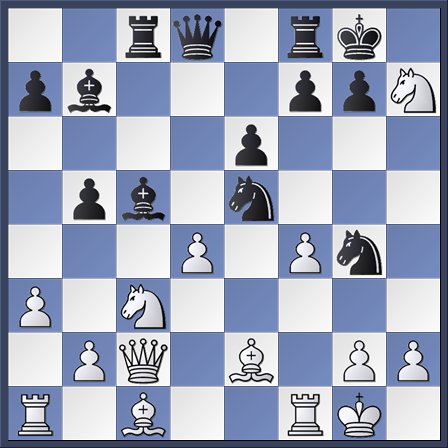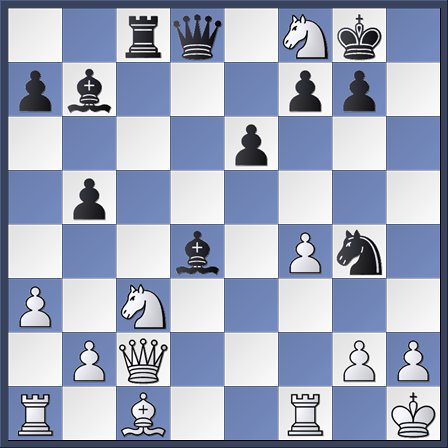Today we have cause to celebrate. I am breaking the months-long chess drought at this blog. You see, the future game of the year was just played in the big chess tournament at Wijk aan Zee in the Netherlands, and I could not live with myself if I did not share it with you.
Playing white is Levon Aronian, currently ranked number two in the world. Playing black is Viswanathan Anand, the current World Champion. Anand's results over the last few years have not been up to his historical standards. He barely managed to keep his title last year, and he has not won a tournament in over four years. There has been a lot of chatter among chess players recently that he has lost his mojo, and perhaps should consider retiring. I would imagine, then, that this win must have been especially sweet.
We pick up the action eleven moves in:

The true chess afficionados among you will recognize that this position emerged from the Semi-Slav Defense. White has just moved his knight from f3 to g5, which, together with white's queen and light-squared bishop, menace black's h-pawn. On his previous move black moved his rook from a8 to c8. That sets up an interesting question
You see, while Anand's rook move is not new in this position, it is less common than the move 10. ... a6. This move is very natural. Black's main goal in these sorts of double queen pawn openings is to play his pawn to c5 under favorable circumstances. This move frees his position and gets rid of a weak, backward pawn. The problem with playing the pawn to c5 directly is that the pawn on b5 is then left without protection. So moving the pawn to a6 first, to protect the pawn on b5, makes a lot of sense.
After that more usual move, white's knight move also makes a lot of sense. Of course, black can play the tactical shot 11. ... Bxh2+ 12. Kxh2 Ng4+, and after white gets out of check black will win back the piece with 13. ... Qxg5. The general feeling, though, is that white's two bishops and better coordination give him a strong position.
The significance of this game is that Anand showed why white's Ng5 idea is a bit dubious after Rc8. Black did not go for the tactical shot, nor did he worry about the weak h-pawn, nor did he worry about a weakness on b5. He simply played 12. ... c5 right away. The line-up of the black rook on c8 with the white queen on c2 gives black a lot of tactical possibilities. White replied with 13. Nxh7, grabbing a pawn and threatening the rook on f8. Anand then played 13. ... Ng4, leading to this position:

Suddenly black has quite the attack. Both of his bishops are pointed ominously at white's king, and black's knight on g4 is soon to be joined by the queen arriving on h4. That's a lot of firepower. White played 14. f4. This closes the black bishop's path to h2. Sadly, white closes one diagonal only by opening another. Anand pounced on this. After trading pawns in the center with 14. ... cxd4 15. exd4, he uncorked the astonishing 15. ... Bc5!!

We amateur types probably would not even consider this move. That's why the GM's make the big bucks.
Can't white just take black's bishop with his pawn? Well, yes. But it won't go well for him. Black will reply with Nxc5, and suddenly white has all sorts of problems. Black is threatening both to win back the piece by taking the white bishop on d3, and also to play Qd4+. taking advantage of the diagonal opened by white when he moved his pawn to f4. The tactics get very messy to calculate, but suffice it to say that black is doing very well indeed.
So white tried 16. Be2, with the idea of chasing back the black knight on g4. If black were actually forced to retreat now, this would be a good move. Sadly for white, Anand has another trick up his sleeve. He played 16. ... Nde5!! (That's right! Two double exclam moves in a row!!)

Let's take stock. Black's bishop on c5, his knight on e5, and his rook on f8 are all under attack. If the knight on e5 moves, then the knight on g4 will be hanging. But white is the one in big trouble!
Calculating all the variations would lengthen this post beyond decency, so let's just look at how things went. Play continued 17. Bxg4 Bxd4+ 18. Kh1 Nxg4 19. Nxf8:

We have reached a critical moment. White is up a full rook, but he is still facing a strong attack. It looks like black could now play the crushing move Qh4. He must resist the temptation to do so, however, since white would then get the last laugh by playing Qh7+. Black would be forced to exchange queens, after which his attack is kaput and white will just be up an exchange. So black played another double exclam move with 19. ... f5!!.
These quiet moves are always the hardest to find. Black simply shuts down the diagonal leading from c4 to h7. Now he really is threatening to play Qh4, after which white will run out of time before finding a reasonable defense.
The game now concluded with 20. Ng6 Qf6 21. h3 Qxg6 22. Qe2 Qh5 23. Qd3 Be3!:

And white resigned. Notice that the white pawn on g2 is pinned by the black bishop on b7. That means that black could take the pawn on h3 with his queen, without worrying about being captured in turn by the white pawn on g2. White played his queen to d3 to protect the pawn on h3. Alas, with his last move Anand simply cut off the queen's path to h3, leaving white with no way at all to prevent checkmate.
A masterful game by Anand. After four rounds he has two wins and two draws, putting him in a tie for the lead. Hopefully he will be able to maintain this form through the rest of the tournament.
- Log in to post comments

I agree, amazing moves.
'We amateur types probably would not even consider this move. '
But would Fritz?
"are all under attack"
Like Tal remarked - White can only take one piece a time.
Brilliant game.
@Steven C: Fritz is outdated. These days it's Houdini or Rybka.
It's brilliant how black managed to turn the tables, thank you for the detailed analysis, great game.
The way Wang Hao finished off l"Ami is also quite impressive.
Whew! What a bunch of shots! Not all home preparation, either. Anand had studied this line preparing for his match with Gulko, but couldn't recall all the details and spent a good amount of time on the position after the eleventh move. He was very proud of finding 19...f5 over the board. I can't imagine finding this at all, but can you imagine finding it from say 3 moves earlier? Unreal, with the last move the icing on the cake. Definitely game of the year! Thanks for posting it.